As an Amazon Associate I earn from qualifying purchases.
Cutting a whole chicken, pheasant, grouse or turkey is exactly the same process — they are all related, gallinaceous birds, after all. I’ll walk you through how to cut up a chicken or grouse for cooking step by step so you can make the best use of all the parts.
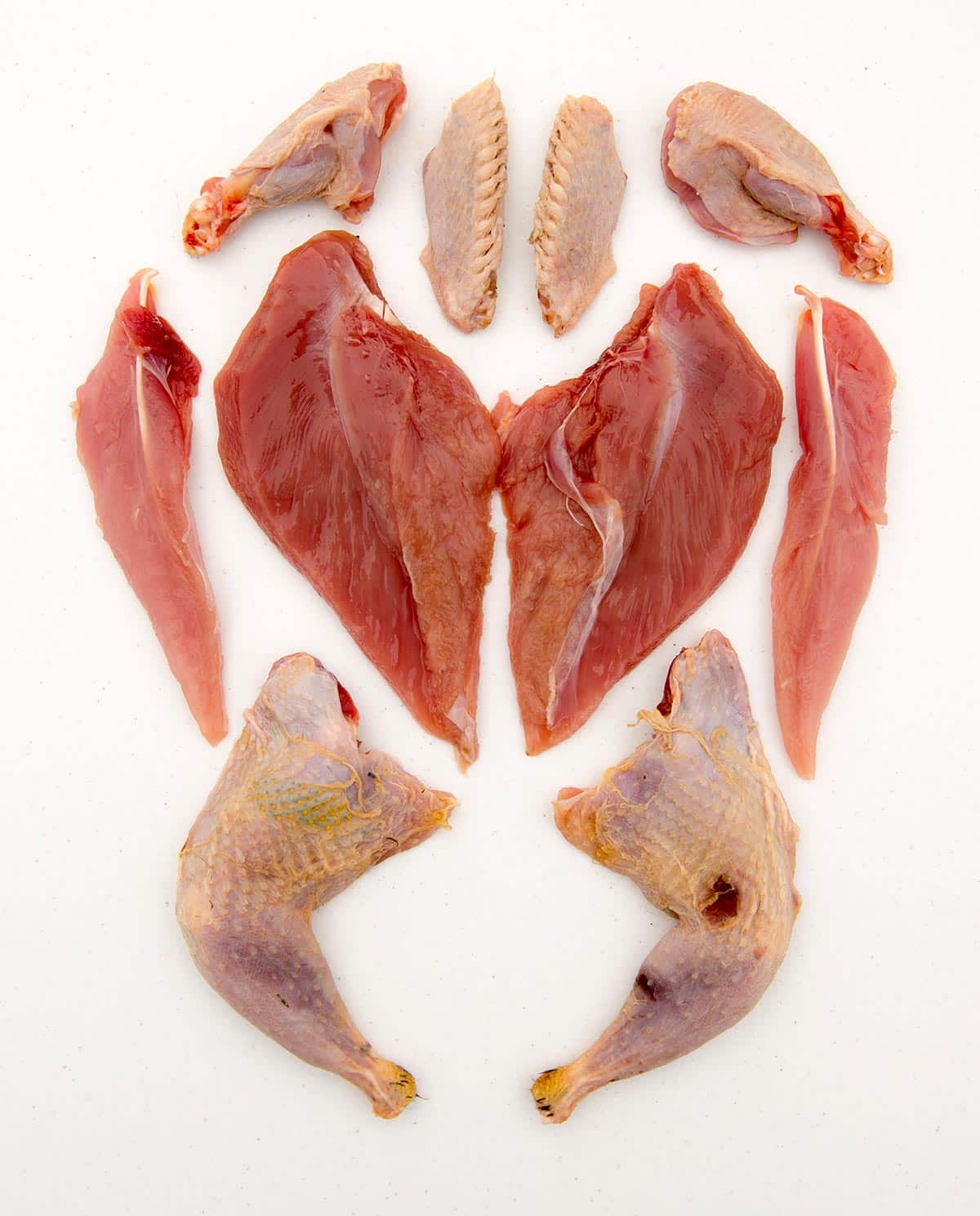
Cutting a whole chicken or game bird is a basic skill you will want to know. For buyers of poultry, buying a whole chicken or turkey is more economical — so if you can cut up a chicken by yourself, you will save a lot of money. And each part cooks a little differently, so you can make the best use of the wings, legs, breasts and carcass.
This is especially true of upland game birds like pheasants, grouse and wild turkeys, Not every bird is worthy of a full-on roast: To me, such a bird needs to be fat, reasonably young and not terribly shot-up. For chickens, old birds like stewing hens are much better cut up than roasted whole.
For upland game birds with broken legs, shot-up breasts, that are skinny or very old, I break them down into parts for separate cooking. Breasts get seared, while legs and wings go into their own kinds of recipes. The carcasses all go into stocks and broth. I waste very little. Here’s how I turn a whole game bird into parts:
I am using a blue grouse for these step by step illustrations, but remember that cutting a whole chicken is exactly the same.
Also, this is just one method for cutting up a whole chicken or pheasant. There are many others, depending on how you plan on cooking them.
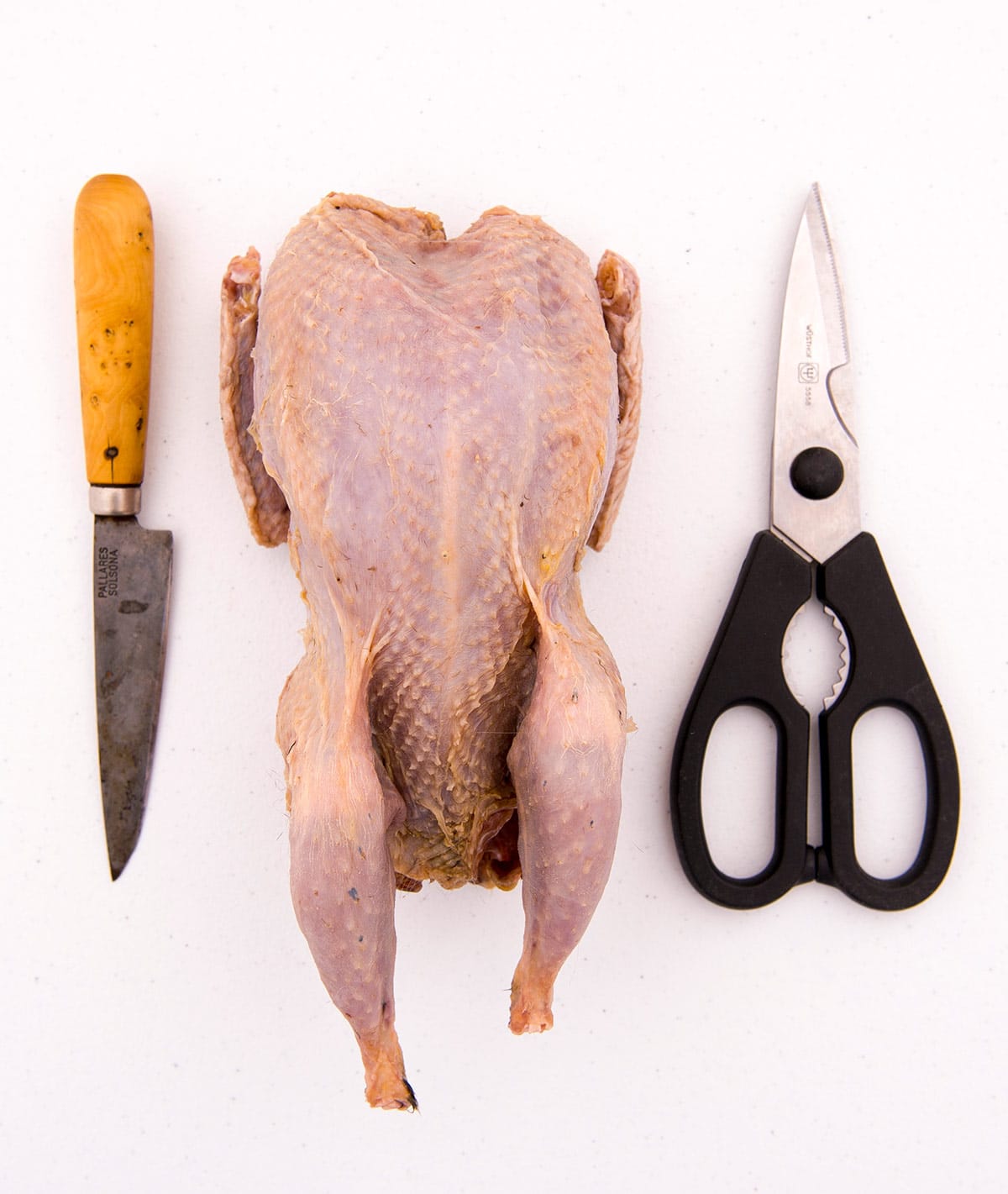
Cutting a Whole Chicken, Pheasant or Grouse
Obviously, start with a while chicken, pheasant, grouse, turkey, partridge or quail. These last two are built the same as a chicken, but are small enough where few people bother to cut them into their component parts; Cornish game hens are similar.
You will want a sharp paring or boning knife, and good poultry shears, I prefer shears with a bone notch that break into two pieces for easy cleaning.
Side note for hunters: This process works for both skinless and plucked birds.
Removing the Legs
Start with the legs. I press on the gap between legs and breast to push as much skin toward the thigh as I can. Slice down in the gap and you will notice you just sliced skin, not muscle — that’s the key. Gently cut downward until you reach the ball-and-socket joint where the leg is attached.
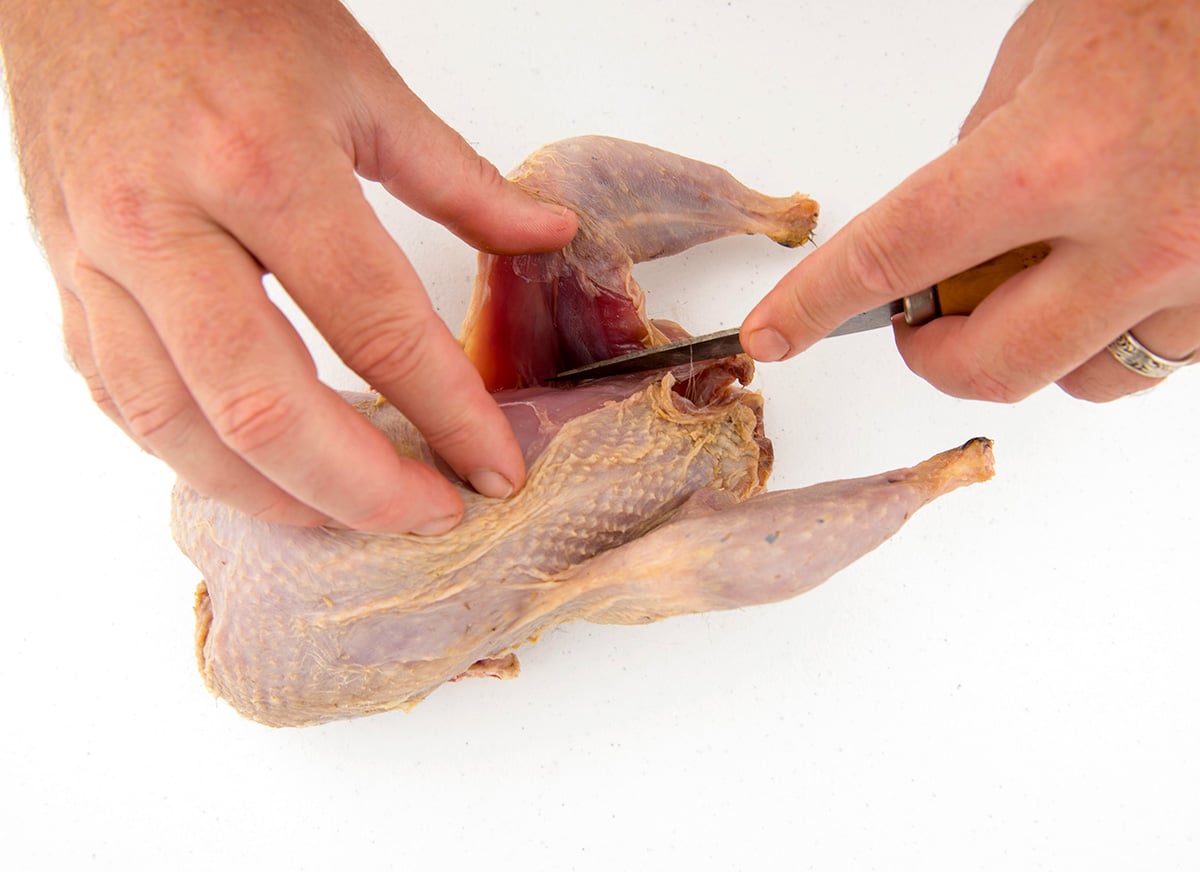
Snap the leg back toward you to pop open the ball-and-socket joint, which frees the leg/thigh.
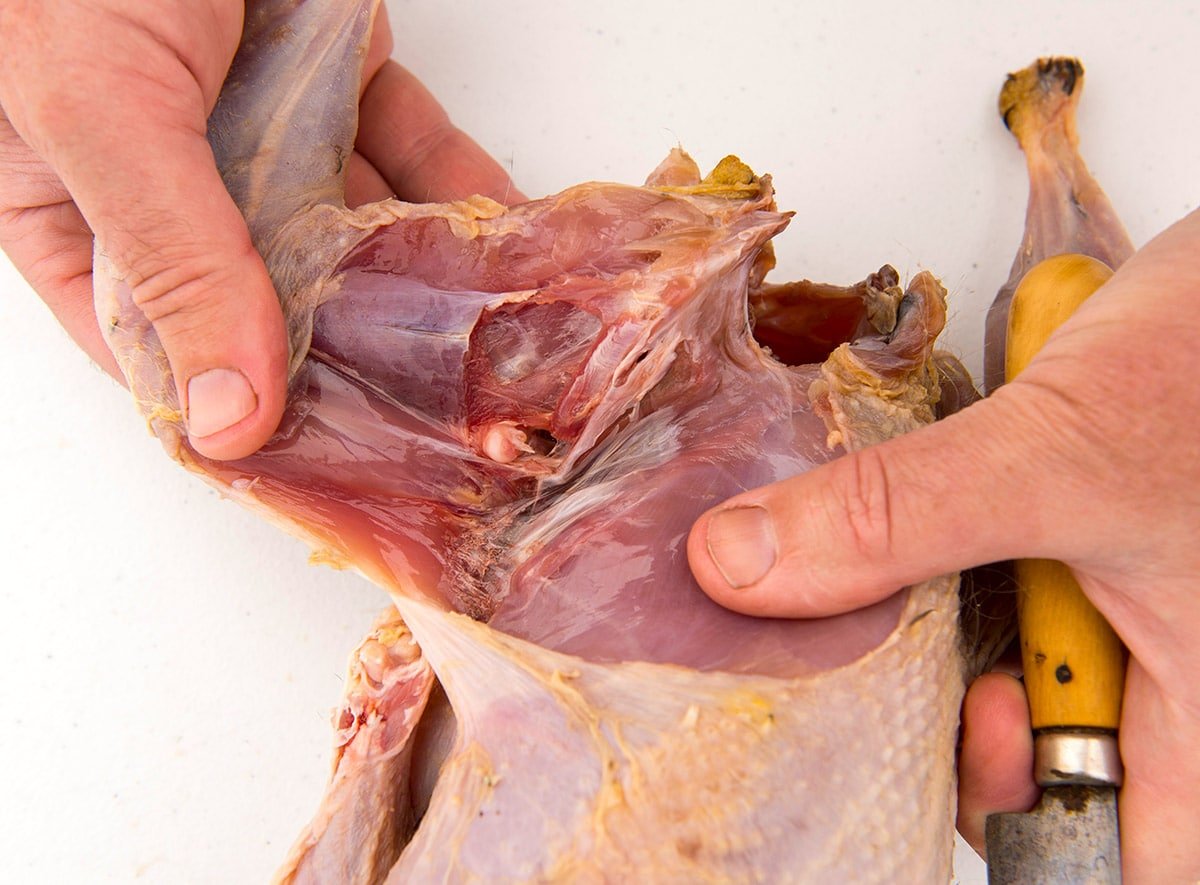
Tuck the knife behind the ball and cut the leg free. As you cut past the socket joint, don’t forget to arc the knife around the little pocket of meat known in birds as the “oyster,” as this is the best part. The oyster is small in grouse, but is large in turkeys, chicken and pheasants.
As you slice down, arc the knife under the back of the bird to get all the meat off the thigh.
If you want to separate thighs from drumsticks, bend the leg a few times to see exactly where the joint is. Place the blade at that spot and slice downward, and you should go right through cartilage, not bone. It takes a little practice to get this correct every time.
Taking off the Wings
When cutting a whole chicken, you will usually want to remove all three digits of the wings, unless you are going to make airline breasts. In that case, you leave the drumette on. The three digits are the wing tip, the flat and the drumette.
With upland game birds, many hunters snip off the whole wing. This is a shame, because the drumette is not only tasty and large in pheasants and turkeys, but leaving it on allows you to make those airline breasts, or it serves as protection for the breast if you are going to roast a whole bird.
I happen to have several great recipes for pheasant wings and turkey wings, if you need a reason to keep them.
Start by snipping off the wing tips, if they are there. Use them for stock or broth. Next, use shears to snip off the flats. There is a joint you can take advantage of so you just snip through cartilage. Bend the wing a few times so you can visualize it.
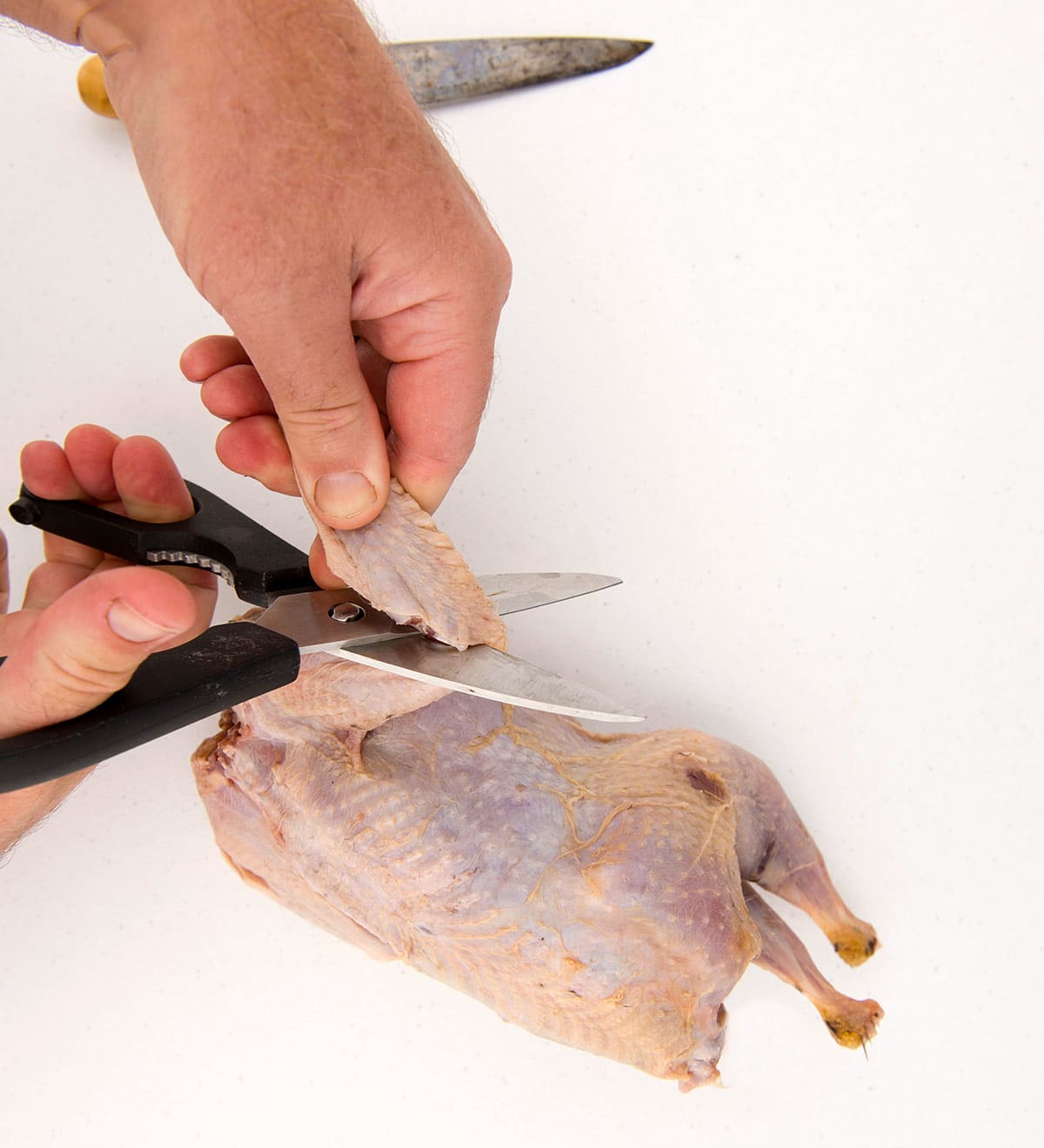
Now comes the hardest part of cutting a whole chicken, pheasant or grouse: Removing the drumette. The drumette is attached at a joint tight under the front of the breast. The easiest way to spot it is to put the bird on its back and move the drumette back and forth. Slice down there.
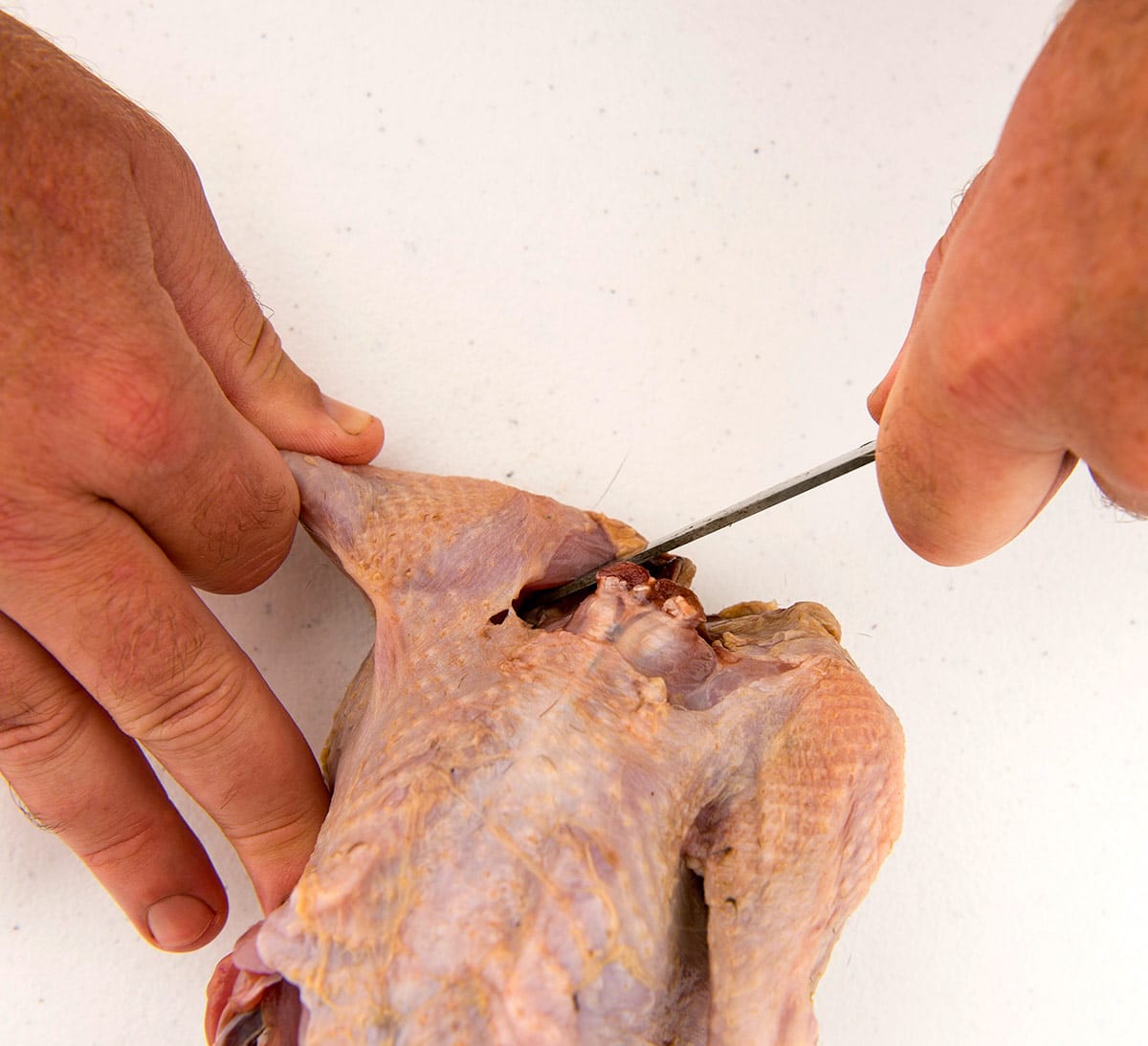
If you cut in the right spot, you will go right through the soft cartilage and free the wing from the body. Don’t worry if you mess it up a few times; it takes practice to know exactly where that spot is.
Now slide the knife along the saber bone, which is a long, curved bone along the bird’s back that looks like a sword; you can see it in the picture above left. Slide the knife along that bone until you get to the joint, which will now be totally free from the body. Finish by removing the wing by cutting a little extra skin from the neck area.
Do this on both sides.
Breasting the Bird
There are a bunch of ways to breast out a chicken, pheasant or grouse. Some people lift up the whole breastbone and use shears to remove it at the wing joints. This is a nice method that preserves the skin on the breast — kinda sorta.
But chickens, pheasants, turkeys and some grouse are built in such a way that the skin coverage isn’t great once you remove the legs. This is very different from ducks and geese.
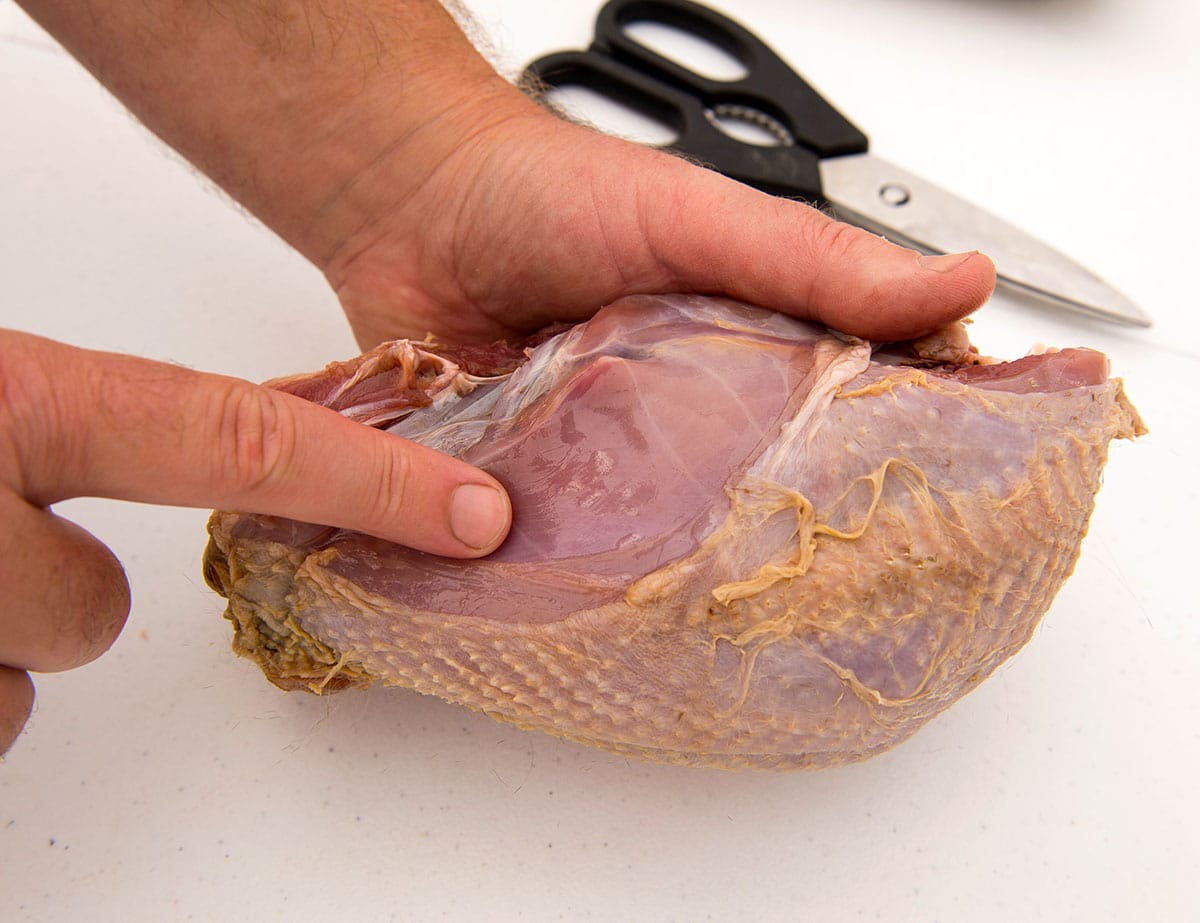
You’ll always have that gap where you removed the legs, so there will always be an area of the breast with no skin protection. So I pull off the skin. Yes, it seems like it’s defeating the point of cutting a whole chicken, pheasant or grouse, but I like to use that stray skin as either a chef’s treat or to make chicken or pheasant skin tacos. Simply cut the skin into pieces and fry them crispy. They’re amazing.
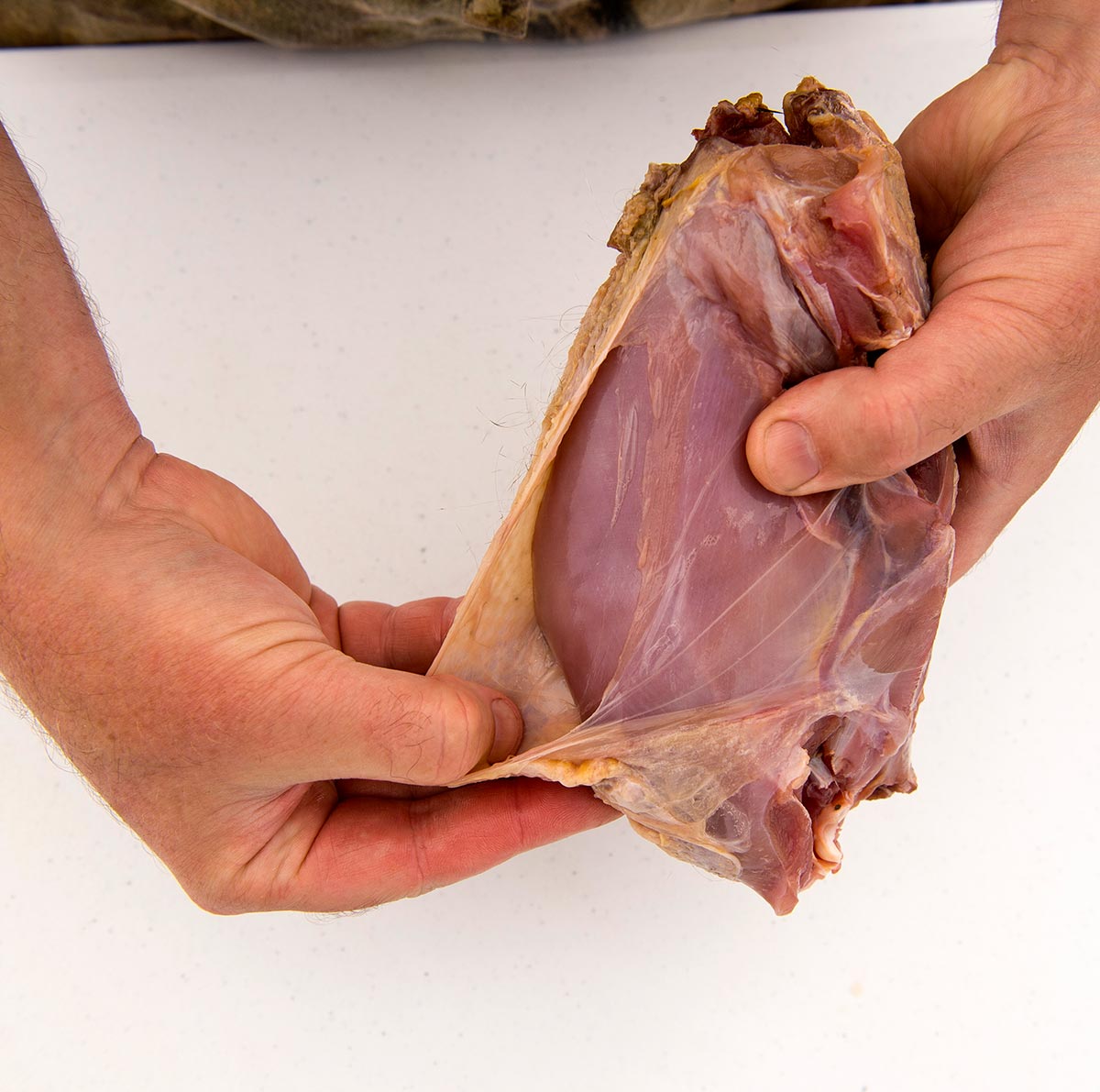
After that, slide your knife down right alongside the keel bone until you hit the breast bone. Tap the point of the knife on the breast bone as you slice back towards the tail, then up to the wishbone. Closely follow the wishbone with your knife.
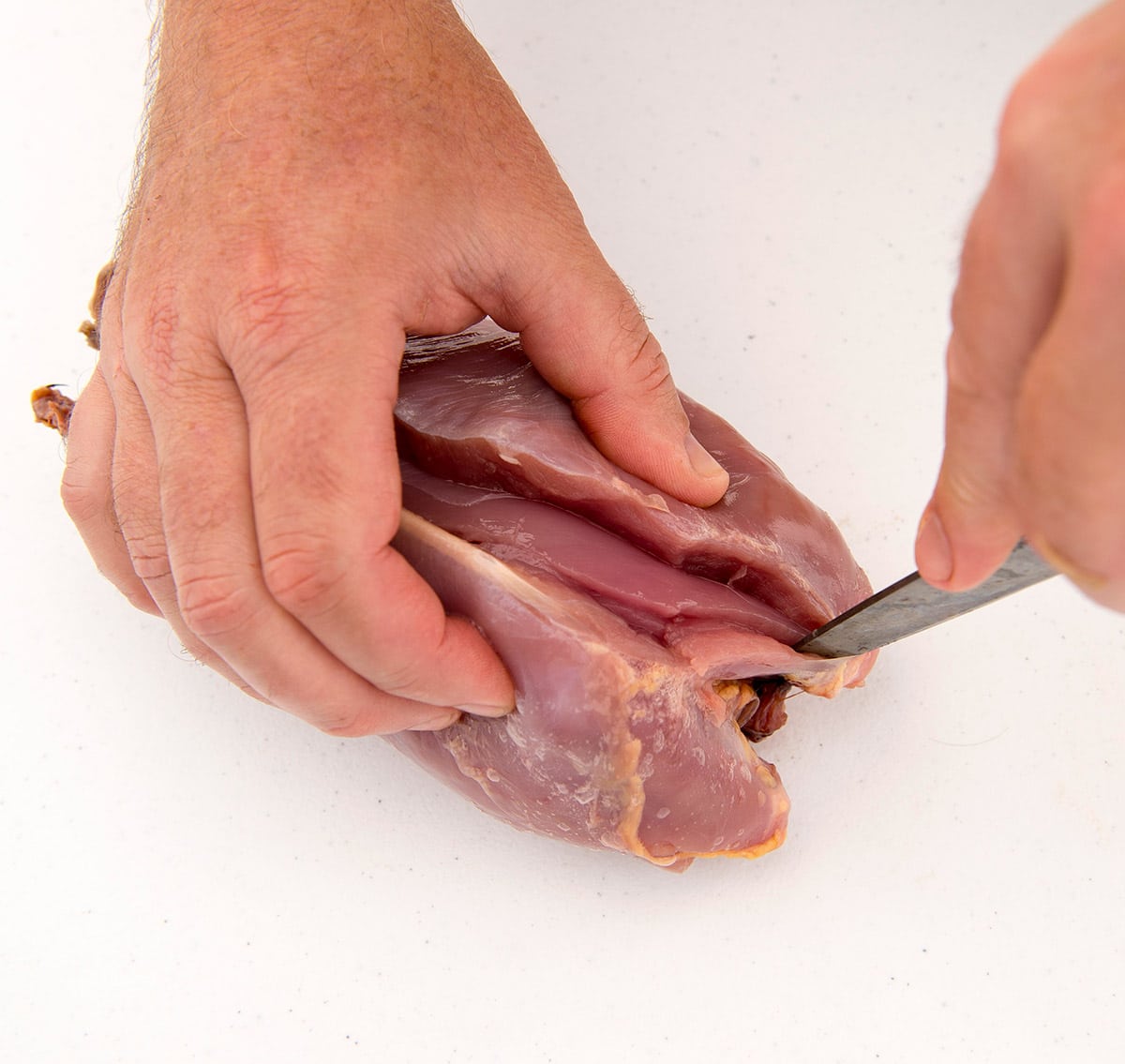
Use you knife to carefully and gently free the breast from the bones. Always have the knife in contact with the bone so you don’t waste meat. If you mess up, all is not lost: Having some meat on the bones makes a better stock or broth later.
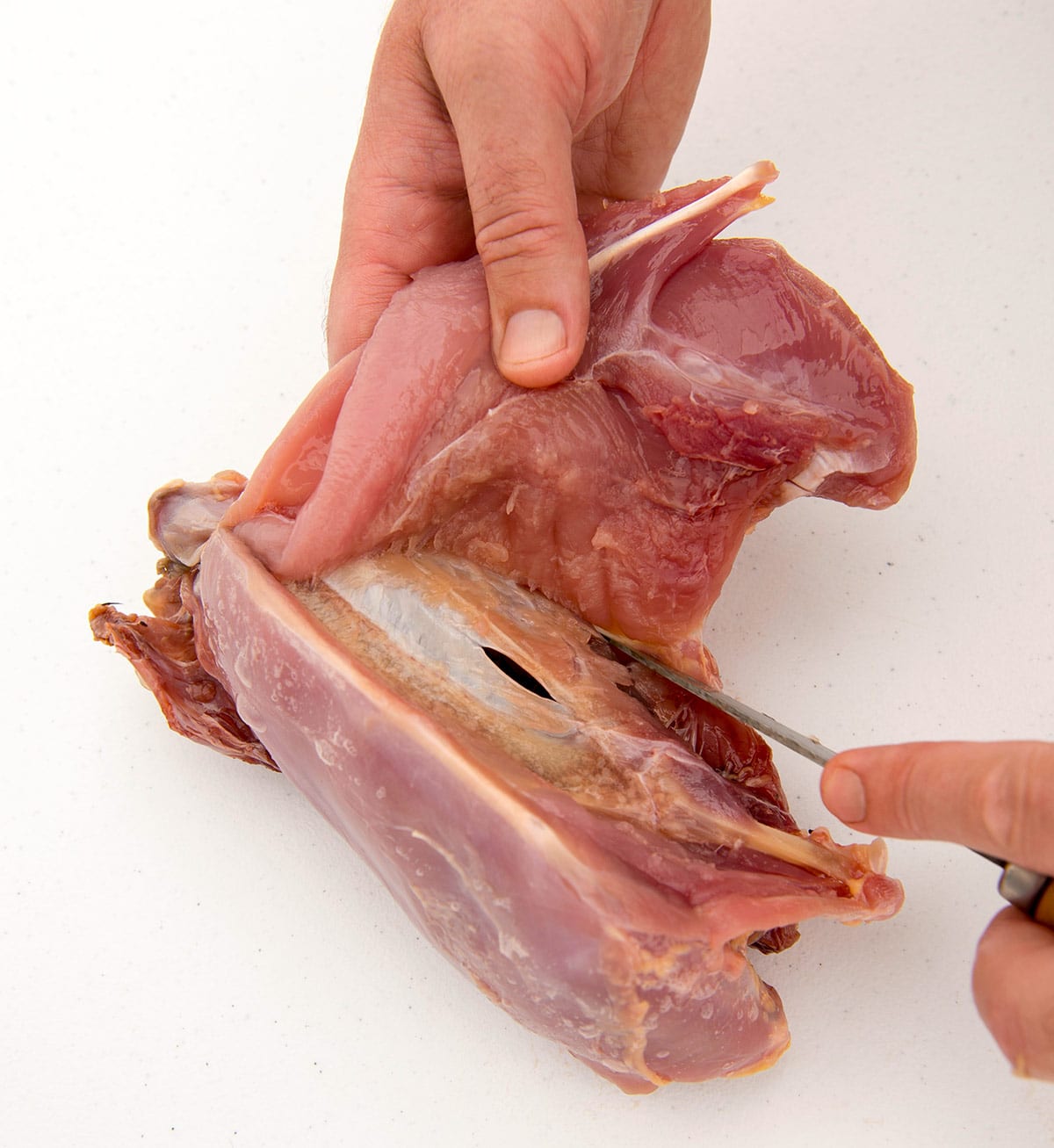
Don’t forget to remove the tender from inside the breast. On chickens it’s the same color as the breast. On many upland game birds, it’s lighter in color. You need to remove it because if you leave the tender on the breast when you cook it, it will curl up and cause that side of the breast to cook unevenly.
I save tenders from my birds and when I have enough, I use them in their own dish, like fried tenders or in a stir fry; they are perfect in kung pao chicken.

There you go. Now you’re done.
My advice: Take your time at first, study the pictures and feel free to ask me questions. Cutting a whole chicken, pheasant, turkey or grouse is not hard. Every bird will be easier than the last one you did, and with minor changes, this technique for cutting up a carcass works with any bird: ducks, geese, pigeons, you name it.
Once you get the hang of it, it only takes a few minutes to break down a bird.
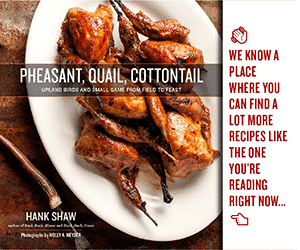
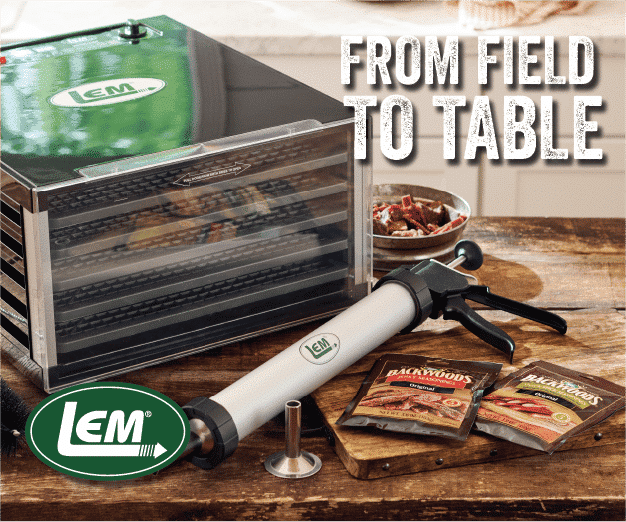


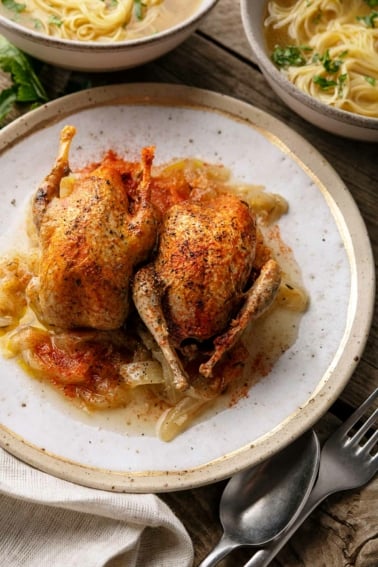
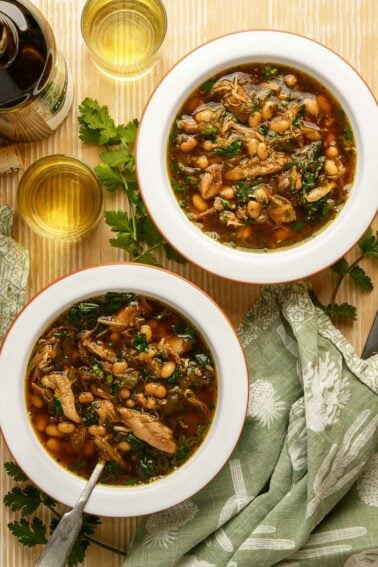
I need a brine that I can use on my ducks for a smoker. I don’t know what kind of wood to use when smoking. I have made duck jerky many times and it always comes out too salty. It takes forever to smoke them and the texture is less than desirable.
If you could help me that would be great.
Jeff: Here is my recipe for smoked duck: https://honest-food.net/how-to-make-smoked-duck/
Hello Hank,
Unfortunately, this comment comes too late, as I’ve already dealt with the birds, but I’m hoping that you can offer some suggestions for next time. This is my first year hunting and I was lucky to take four ruffed grouse today. I laid the birds on snow in a plastic bag as I collected them. They went into a cooler with ice packs and were cleaned about 4 hours later. My problem is that most of the birds were gut shot and smelled badly of bacteria once I skinned and gutted them. I chose to breast out the birds, which was a shame because I was hoping to do more with the carcasses. I tried rinsing out the carcasses but they still smelled after thoroughly working them under cold water. Was there something I could/should have done differently?
Thanks,
jason
Jason: Ruffed grouse innards stink no matter what. I just wash the insides out really well and use a paper towel to dry it afterwards. A slight bit o’funk is part of the glory of a ruffed grouse… within reason.
You are more than welcome Hank. Actually that hardly even covers it. As I said, the book was a God-send. It showed me that the sky was the limit, and provided the basics I needed to try different things and create my own dishes.
Through my own experience (admittedly, way too long) I was just starting to catch on to the medium-rare mantra. Then an article in Field and Stream a few years back called The Duck Course got me started making some killer duck dishes, and shortly after that I got your book, and suddenly I couldn’t shoot enough ducks to satisfy my appetite, lol.
Then I discovered your blog here, I was like wow, this dude is my hero! As I also love to hunt just about everything, fish pretty much year round, grow fresh herbs, forage for all manner of wild eats like berries, asparagus and wild mushrooms; and find delicious ways to cook and enjoy all of it to the max.
So needless to say, I am going to be living on here for the foreseeable future. One thing I haven’t seen here yet is one of my absolute faves: Pickled asparagus. I got a great recipe if you want it, but I am sure you can come up with one of your own that would rival it! 😉
Chad
I got a copy of duck duck goose for Christmas last year. Best gift ever! As my wife and I shoot a lot of ducks and geese and have struggled in the past to find many good ways to eat them besides making jerky.
It has opened up a whole new world for me. I have enjoyed waterfowl meat more than ever before! (and as much or more than a lot of other things too!) Nowadays it almost seems a disgrace to make any of it into jerky.
Here’s the thing though: I had always skinned 99% of my birds. I didn’t know about this wet plucking thing so I had always dry plucked and singed. It was such a brutally time consuming process, that I would only do 1-2 per season – and couldn’t even begin to fathom how one might do it with all or most of the birds they shot.
After I got the book though, I at least plucked off every breast thereafter and was searing and pan-saucing like a madman. Well, this season, I am ready to take it to the next level and start plucking a mess of birds, rendering fat, making stock and all that jazz.
Just finished watching the wet plucking video, so now that I can finally envision how to do that and how it works (blew my mind by the way), I am stoked and ready to go. Just got to find me some paraffin wax. I can honestly say I have never noticed it in the grocery stores around here, but I haven’t ever been looking for it either.
So all this leads up to my question finally. Can you pluck ducks and save (eat) the skin this early in the year? I just finished processing my first limit from the Idaho opener last weekend, and it seemed like they had way too many of those juicy not-yet-emerged feathers that are deep within the skin and only have a teeny little tuft of dry material to grab (I think they are called pin feathers but I am not positive). Does the wax get them out too, or is it actually necessary to get every single one of them out? They don’t really seem like anything you would wanted cooked into that yummy skin that you’re going to eat. . .
Chad: Thanks for the kind words! Really makes my day to hear that. Yes, we wax birds this early in the year. I use a bit more wax per duck, and I tend to pull the wax off downward, i.e., toward the feet. This direction seems to grab more of the pinfeathers.
Hi Hank,
I recently removed both whole legs off a domestic goose in order to make confit for a recipe of garbure. Left with a bird minus its legs, is it still possible to roast it “as is” and remove the breast meat at some point, then finish them to a tender medium rare in a skillet as you suggest in your Roast Goose recipe? (I also like the resulting stock I make from the roasted carcass.)
Would I need to make any adjustments to your recipe other than skip the steps regarding the legs?
Lucky
ok, so I have a benefactor hunter that drops off geese and ducks – I am so lucky! so far I have tried to pluck the ducks to no avail so I have resorted to just breasting them out. I would love not to waste the rest of the bird even if i’m just making soup stock.
pray tell… how do you use wax to pluck a duck?
Hi Hank,
I broke down a pheasant last night, and cut it into small strips for stir-fry. I came across some pin-like bones in the lower leg section. Are these worth removing or will they cook down like those tough venison tendons that melt out in cooking?
Thanks so much for your help and blog! I love it.
Amanda
Tim and Chris: Yes, sort of. While I have not yet posted specifically how to pluck a duck (which requires wax), I have talked about how to pluck a pheasant, and this technique works for chickens, turkeys, quail, grouse, chukars and other partridges.
has there been a reply to the de-feathering birds request?
Great post, wonderful pictures. I have another tutorial request. How about de-feathering birds? It seems that there are so many techniques. Which is the most reliable?
Hank, Happy New Year! Hope Holly is recovering well? Thanks for the breakdown on a breakdown! 🙂 Nicely done and well documented.
Excellent instructions and illustrations, Hank. More detailed than my Joy of Cooking… smile. It’s perfect for novices and for anybody who wants to check their technique.
Sylvie
https://www.LaughingDuckGardens.com/ldblog.php
Funder: I am planning on deep-frying the tenderloins, either like chicken-fried steak or as a tempura. I’ll let you know how it turns out.
Great post, thank you! I’ve been practicing on chickens, but I’m not nearly as good as you yet. I’m gonna try your breasting technique. (That sounds racy!)
What do you like to do with the tenderloins? I’ve always cooked them with the breast, but I’m definitely open to new ideas.
Great tutorial…I’ve been wanting to do a duck for awhile now (though I’m going to let someone else shoot it for me).
I second the rabbit tutorial, too. Good info!
Josh: You should cook pheasant in pheasant fat…silly! Or chicken or potatoes or onions or parsnips or…well, whatever suits you.
Lang: I need to go find me a bunny before I can do that. I should be able to get on in a week or two. Check back then!
Excellent info as usual. How about a rabbit tutorial?
Great post, I’ll be referring to it if I ever shoot another animal.
By the way, I used an earlier, great post of yours and rendered some pheasant fat. Now, what should I use it in?
Nice of you to take the time to do all of the great illustrations, Hank 🙂
You’ve reminded me that I have to get my knives sharpened.
Fantastic 101 Hank! The pictures tell the whole story. Nice post.